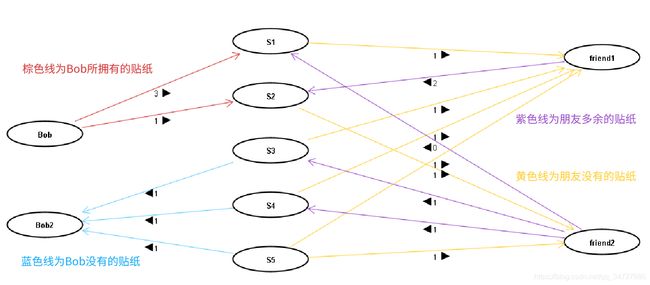ACM Plan - UVa 10779 Collector’s Problem(网络流模板题)
题意
Bob 和朋友换贴纸,他和朋友们都有若干贴纸,Bob 希望通过交换来使自己持有更多种类的贴纸,给出每个人的贴纸持有信息,求Bob 经过交换后能持有的最大贴纸种类数。
Input
格式:
先给出样例数量,每个样例第一行给出参与交换的人数n(包括Bob)和参与交换的贴纸种类数m,接着n行,每行描述一个人,第一行为Bob。先给出此人拥有的贴纸数k,而后k个数代表贴纸的种类
2
2 5
6 1 1 1 1 1 1
3 1 2 2
3 5
4 1 2 1 1
3 2 2 2
5 1 3 4 4 3
Output
Case #1: 1
Case #2: 3
思路
很标准的网络流模板题,只要求一个数,不要求打印方案,稍微有点绕,就是起点和终点都是Bob,可以分成两个Bob。
网络流最重要是建好图(以下边均为单向边),
首先连接 Bob—>他拥有的贴纸建边,权重为Bob持有的该种类贴纸数;
对贴纸和朋友建边,连接 朋友所没有的贴纸—>朋友,权重为1,表示该朋友缺少1张该种类的贴纸;
而后连接 朋友—>朋友多余的贴纸,权重为所持有贴纸数量-1,表示该朋友可以拿出来交换的贴纸;
最后连接 Bob没有的贴纸—>Bob,权重为1,表示Bob 缺少1张该种类的贴纸;
建好图后,直接一个dinic或者edmonds_karp求出答案即可。
样例一图示(这里为了看的清楚没有标出残余图的边):

样例二图示(剩余图的边没有标出):

Code
代码前面为网络流两个算法的模板
#include